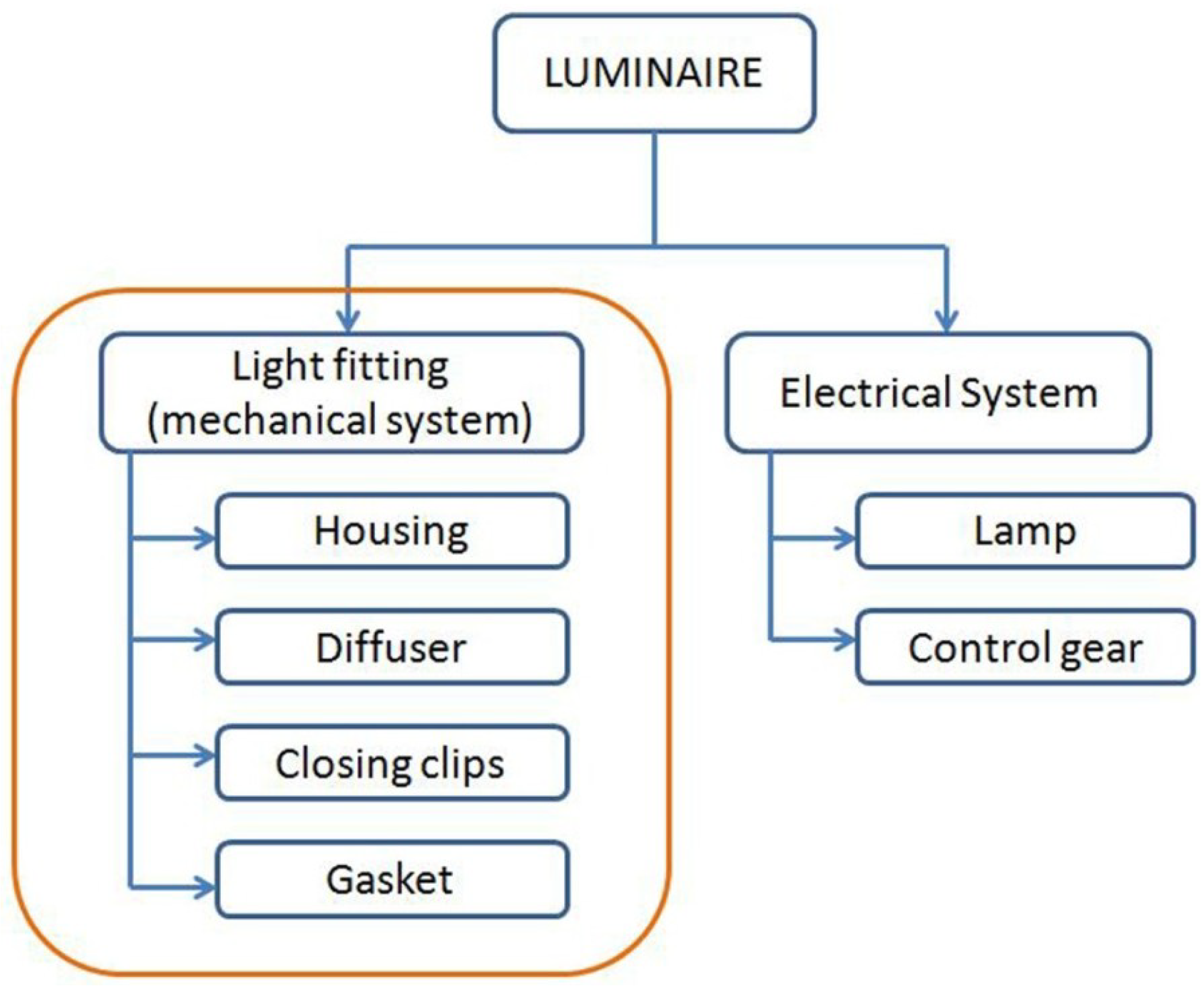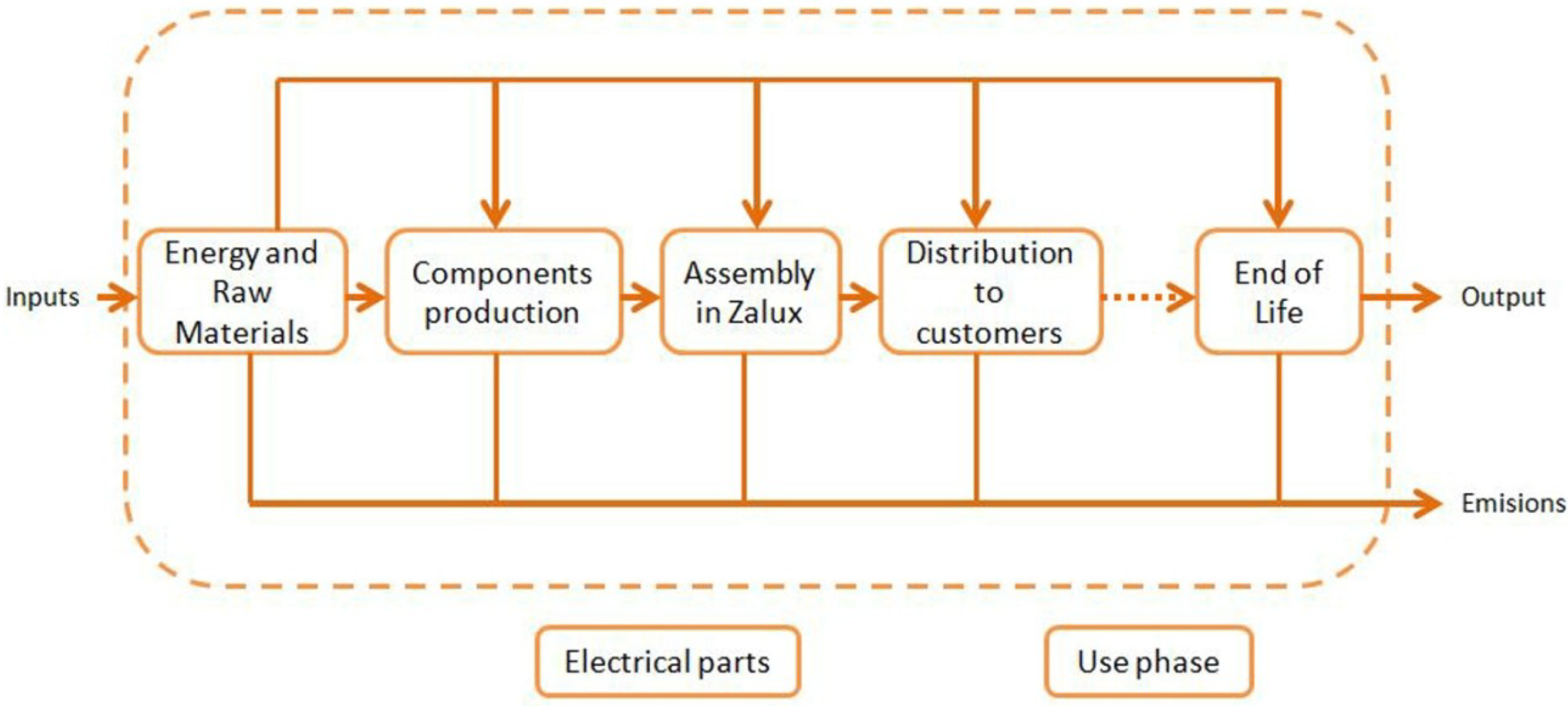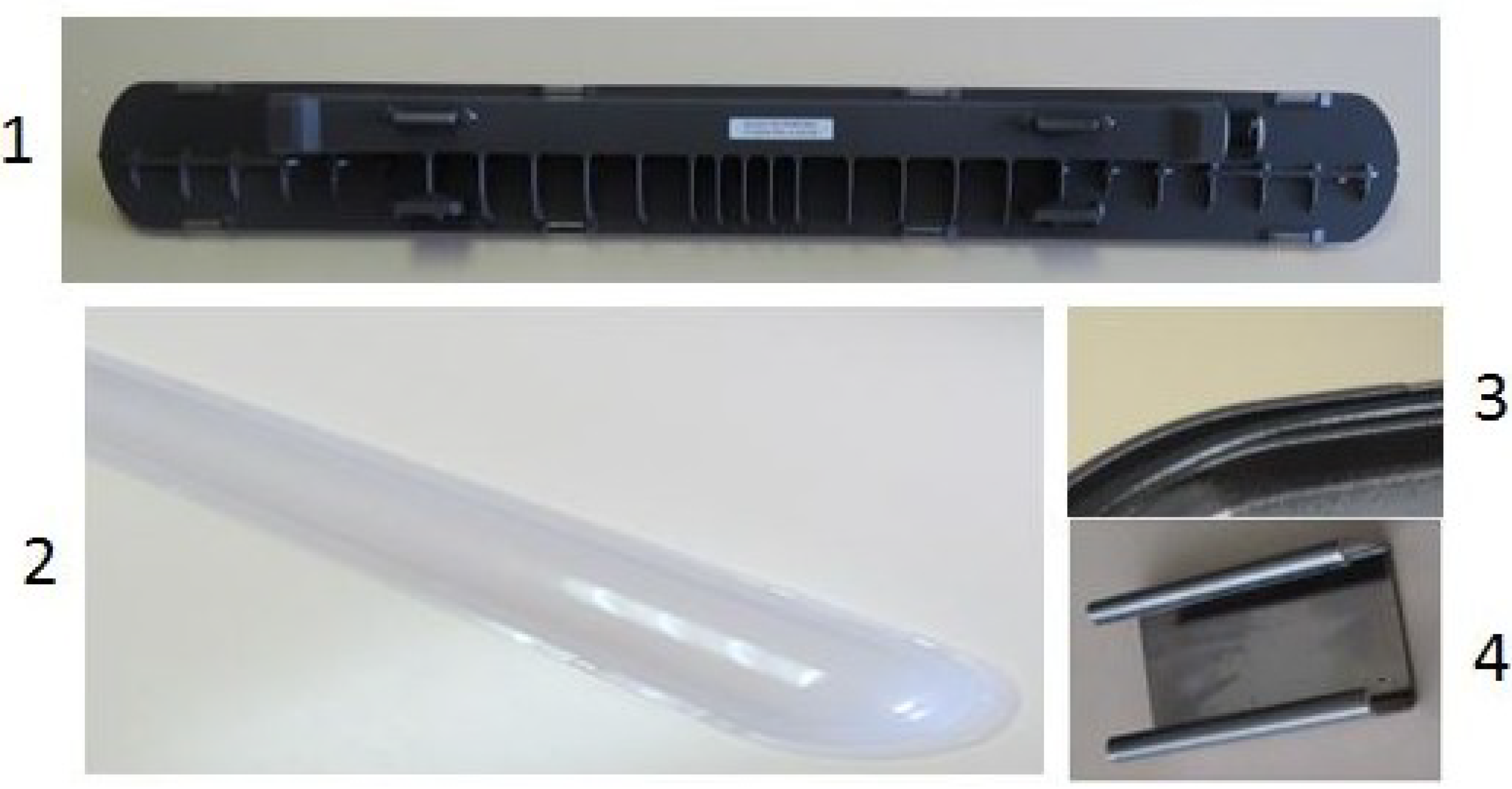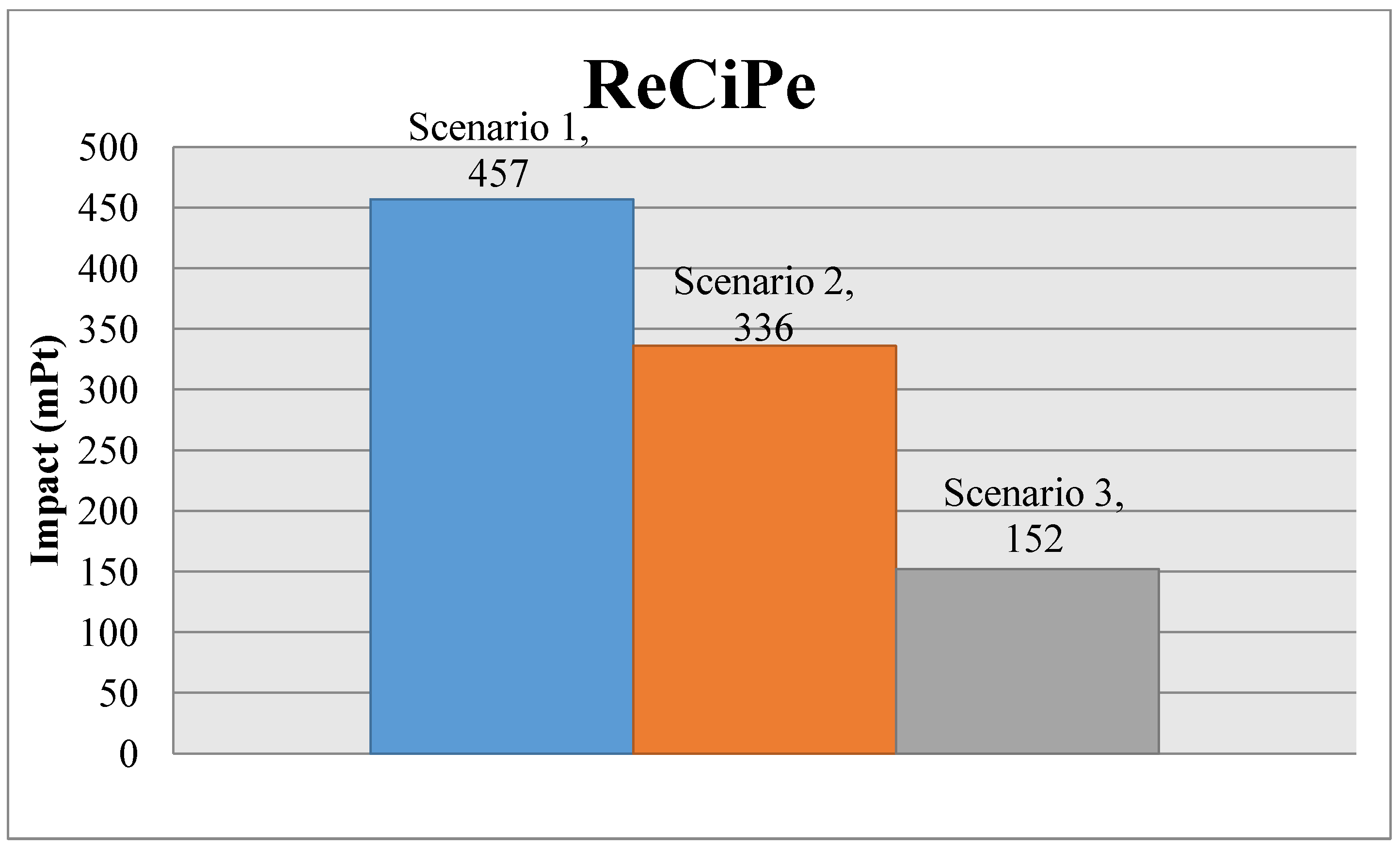1. Introduction
Environmental conscience has been growing gradually in recent decades. In the last few years, several laws have been developed in the European Union in order to reduce the environmental impact of consumer products. These laws are devoted to reduce the use of hazardous substances [
1], control chemicals [
2], enhance the recycling (WEEE, waste of electrical and electronic equipment) [
3] and introduce ecodesign in energy-using and energy-related products [
4,
5].
This paper analyzes the high relevance of material selection and how this choice modifies end of life scenarios, being possible to reduce the environmental impact at the end of life of the product. The paper is focused on analyzing the environmental impact of the product, changing the end of life scenarios in accordance with different business models, analyzing the recycling impact depending on the selected materials by means of a simplified life cycle assessment (LCA) analysis. This analysis has been performed over an LED weatherproof luminaire produced by Zalux S.A. (Alhama de Aragon, Spain). This Spanish company produces more than four million luminaires per year.
The industrial luminaire is a product massively produced around the world. This product is used for different purposes, like lighting in garages, factories and several places where the product is going to be used during the years, or also, it can be used as provisional lighting systems, like construction lighting. A lighting system built with this kind of luminaire can use hundreds of them, using a large amount of material and energy consumption; so, due to the large quantity of luminaries used around the world, the optimization of the environmental impact of this product is important, reducing the environmental impact at all of the different phases of the life cycle, this being a benefit for society.
These weatherproof luminaires are composed of two main parts: the electrical system, composed of the lamp and the control gear, and the light fitting, which is the mechanical system that protects the electrical one. The main parts of a light fitting are the housing, where the electrical system is fixed, the diffuser, which closes the luminaire and diffuses the light, closing clips and a gasket, which ensures the watertightness.
Figure 1 shows the product structure, with the parts we have focused our efforts on in this paper mentioned.
Figure 1.
Product structure.
Figure 1.
Product structure.
Traditionally, these weatherproof light fittings were produced with plastics and designed as a simple box, where the lighting system was introduced, but nowadays, due to the LED revolution, the technology of these light fittings is getting more complicated. An LED generates between a 60%–70% heat from the power it consumes. As far as semiconductor technology is very temperature sensitive, this heat reduces its performance and its lifetime, so heat dissipation has become the key to success when developing luminaires with LED technology [
6,
7]. New materials are being used, like aluminum for the housings to improve heat dissipation for the LED lamp, or polycarbonates (PC’s) and polymethyl methacrylates (PMMA’s) for the light diffuser, to increase the efficiency of the luminaire by means of a good light transmittance. The evolution of LEDs is making it possible to use polymers also for the housing, as far as they are being thermally improved, so that there are different possibilities when choosing a material. Furthermore, to protect the LED from inappropriate handling, these light fittings are being designed to be maintenance free, that is, the light fitting cannot be opened; so, when it reaches its end of life, the whole luminaire is discarded without repairing it.
There is potential for improvement in order to reduce the environmental impact of these luminaires. The biggest efforts are usually focused on the efficiency of the lighting system, reducing the environmental impact during the use phase of the product, where the main environmental impact is produced [
8,
9,
10,
11]. In spite of that, the other phases of the life cycle should not be overlooked, as improvements in the mechanical components can also be used to reduce the environmental impact of LED luminaires. Apart from changing consumer behavior, the electricity mix or improving LED efficiency to reduce environmental impact at the use phase, the other way to reduce the environmental impact is by applying design actions to the product through its whole life-cycle.
There is room for improvements on designing the light fittings to reduce the environmental impact of its production processes, reducing the transport impact by means of weight reductions and also very interesting ways of reducing the environmental impact, paying attention to the end of life phase. The selection of the material is a key decision, as far as it is going to affect the weight of the part, the functional specifications, costs and environmental impact. Depending on the selected material, the end of life actions that can be applied to the product could be different.
When the light fitting reaches the end of life, depending on the selected materials, different actions can be applied. There are materials that are easily recycled, like aluminum, but others, like PC, could be recycled, but are not usually recycled. On the other hand, materials, such as sheet molding compound (SMC), cannot be recycled and are sent to incineration or land filling. An adequate material selection will affect the environmental impact, particularly at the end of life of the product if it is recycled.
The recycling of plastics is a complex process, as the properties can change from the ones of the virgin material [
12]. This means that to improve recycling efficiency, designers have to understand the recycling processes, avoiding contaminants [
13,
14]. For example, polyethylene terephthalate (PET) recycling is hugely extended, using super-clean recycling that decontaminates post-consumer contaminants, making it food contact approved [
15]. The recycling of other plastic is not as extended, although it has been broadly studied also for new materials, like bioplastics [
16]. In other cases, instead of mechanical recycling, chemical recycling has also been applied [
17,
18,
19]. Plastic waste management systems have been widely studied [
20,
21,
22,
23]. Furthermore, closed-loop systems have been analyzed for several materials, including plastics containing flame retardants [
24].
This closed-loop system is a business strategy where the product is recovered by the company when it reaches its end of life, to be replaced by a new one, and the old product is processed by the company. This system brings to the company the possibility of recycling the materials on its own, to be reused in their processes, this being a possibility to save money on raw materials, reducing the environmental impact and giving the customer an additional service.
Life cycle assessment (LCA) is a methodology that allows researchers to calculate the environmental burden created by a product. It is very adaptable for used in different products and services. It has been used to assess products, such as wind turbines [
25], electronic boards [
26], nanomaterials [
27], food packaging [
28] or concrete [
29]. The recycling of multiple polymer materials has been analyzed using LCA [
30]: Polyvinyl chloride (PVC) [
31], PET [
32], PMMA [
33] and even mixed plastic waste [
34].
Life cycle assessment has also been used to compare virgin and recycled polymers, finding clear environmental advantages [
35,
36]. A comparison for TV sets between mechanical recycling and energy recovery was performed, finding that the number of different plastics used in a product should be reduced [
37]. Closed-loop recycling was the better environmental option analyzed by [
38]. Although downcycling, recycling with a loss of properties, is currently well known, there are not many examples of product upcycling [
39,
40,
41].
This paper presents the first analysis of the differences of the environmental impact of a light fitting when changing the materials, paying special attention to the end of life, analyzing how the environmental impact is modified by changing the materials. The selection of materials and the end of life scenario is linked to the business strategy, and a closed-loop system is proposed. Three different end of life scenarios have been analyzed, to see the difference in the environmental impact of the product when analyzed following IEC (International Electrotechnical Commission) TR62635 [
42], and also analyzed in accordance with the proposed end of life scenarios in accordance with the closed-loop business strategy.
This environmental impact analysis has been performed by means of the LCA methodology, as the first environmental viability analysis. It has been applied by means of a software program, called Ecotool, developed by the authors. This software is particularly designed to help mechanical designers to perform the environmental assessment of their designs, being applied during the development stage of a product. Several researchers have found that most life cycle assessment tools focus on analyzing existing products, but they are not suitable for designers [
43]. This software allows one to easily configure the LCA inventory and to calculate the environmental impact, by means of simple data input windows.
4. Results and Discussion
In this section, the results of each scenario are shown. In order to reduce the number of combinations shown in
Figure 4, the housing, the diffuser, the gasket and the clips are going to be analyzed separately.
The material, processes and end of life environmental impact are going to be calculated for each part. Manufacturing is the result of adding the environmental impact of the material and the production process, and the end of life is calculated in accordance with the configured scenarios shown in
Section 3.3Then, the complete light fitting analysis will be performed with the assembly of the best combination for the different parts, adding the transportation to customers, using the weight of the optimum assembly, so that the transport environmental impact will be calculated with the total weight of the light fitting. The calculation procedure is as follows: calculation of the environmental impact of the materials, end of life and processes of each part for the different materials.
- (1)
Selection of the lowest impact part depending on the material.
- (2)
Assembly of the light fitting with the lowest impact parts, and calculation of the environmental impact of transport to customer.
Then, we calculate the total impact by adding manufacturing, transport to customers and end of life.
4.1. Scenarios Results
4.1.1. Scenario 1: IEC TR62635
Table 8 shows the result of the individual analysis of each part. The parts with a lower impact are green colored.
The total weight of the light fitting is 863.4 g. The environmental impact of the transport to the customer is 18.96 mPt (ReCiPe) and 0.18 kg
eqCO
2. Therefore, the total impact of the light fitting is:
Table 8.
Results for Scenario 1.
Table 8.
Results for Scenario 1.
| Part | Manufacturing (Materials + Production) | End of Life |
|---|
| ReCiPe (mPt) | Carbon Footprint (kgeqCO2) | ReCiPe (mPt) | Carbon Footprint (kgeqCO2) |
|---|
| Clip plastic | 15.4 | 0.24 | 0.24 | 0.8 |
| Clip steel | 36.7 | 0.16 | −30.8 | −0.08 |
| Diffuser SAN | 142 | 1.38 | 4.46 | 0.07 |
| Diffuser PMMA | 239 | 2.55 | 4.56 | 0.06 |
| Diffuser PC | 237 | 2.75 | 4.56 | 0.06 |
| Gasket | 9.80 | 0.21 | 0.28 | 0.01 |
| Housing SMC | 267 | 2.59 | 8.09 | 0.11 |
| Housing PC | 329 | 3.82 | 6.33 | 0.08 |
| Housing Aluminum | 2412 | 25.3 | −1924 | −20.7 |
The following picture (
Figure 5) shows the software used to calculate the environmental impact, where the final design assembly is shown, with the parts colored in blue. The final results for ReCiPe and for carbon footprint are shown in the picture.
Figure 5.
Results for Scenario 1.
Figure 5.
Results for Scenario 1.
4.1.2. Scenario 2: Half Closed-Loop System
As for Scenario 1, the following table (
Table 9) shows the individual results for each part with the new end of life scenario, with the lower impacting parts green colored.
For this scenario, the environmental impact of the transport to the customer is multiplied by 1.5, as far as half of the light fittings return to the factory, so that half of the environmental impact of the transport to the customer is added again in returning operation of the old product.
Table 9.
Results for Scenario 2.
Table 9.
Results for Scenario 2.
| Part | Manufacturing (Materials + Production) | End of Life |
|---|
| ReCiPe (mPt) | Carbon Footprint (kgeqCO2) | ReCiPe (mPt) | Carbon Footprint (kgeqCO2) |
|---|
| Clip plastic | 15.4 | 0.18 | 0.29 | 0.0 |
| Clip steel | 36.7 | 0.16 | −31.8 | −0.12 |
| Diffuser SAN | 142 | 1.38 | −47.8 | −0.43 |
| Diffuser PMMA | 239 | 2.55 | −92.9 | −0.99 |
| Diffuser PC | 237 | 2.75 | −92.2 | −1.09 |
| Gasket | 9.80 | 0.21 | 0.28 | 0.01 |
| Housing SMC | 267 | 2.58 | 8.09 | 0.11 |
| Housing PC | 329 | 3.82 | −128 | −1.51 |
| Housing Aluminum | 2412 | 25.3 | −2019 | −21.7 |
The total weight of the light fitting is 743.4 g. The environmental impact of the transport to the customer is 16.3 mPt (ReCiPe) and 0.15 kg
eqCO
2, but taking into account the returning to the factory of half of the light fittings, the total transport impact is 24.5 mPt (ReCiPe) and 0.23 kg
eqCO
2. Therefore, the total impact of the light fitting is:
4.1.3. Scenario 3: Whole Closed-Loop System
The analysis of this scenario follows the same steps as Scenario 2, but changing the end of life scenario as shown in
Section 3.3. The following table (
Table 10) shows the individual results for each part with the new end of life scenario, with the lower impacting parts green colored.
Table 10.
Results for Scenario 3.
Table 10.
Results for Scenario 3.
| Part | Manufacturing (Materials + Production) | End of Life |
|---|
| ReCiPe (mPt) | Carbon Footprint (kgeqCO2) | ReCiPe (mPt) | Carbon Footprint (kgeqCO2) |
|---|
| Clip plastic | 15.5 | 0.18 | 0.3 | 0 |
| Clip steel | 36.7 | 0.18 | −32.8 | −0.12 |
| Diffuser SAN | 142 | 1.38 | −102 | −0.98 |
| Diffuser PMMA | 239 | 2.55 | −192 | −2.08 |
| Diffuser PC | 237 | 2.75 | −191 | −2.28 |
| Gasket | 9.80 | 0.21 | 0.28 | 0.01 |
| Housing SMC | 267 | 2.58 | 8.09 | 0.11 |
| Housing PC | 329 | 3.82 | −264 | −3.16 |
| Housing Aluminum | 2412 | 25.3 | −2114 | −22.8 |
For this scenario, the environmental impact of the transport to customer is multiplied by 2, as far as all the light fittings turn back to the factory, so all the environmental impact of the transport to customer is added again in the turning back operation of the old product.
The total weight of the light fitting is 743.4 g. The environmental impact of the transport to customer is 16.3 mPt (ReCiPe) and 0.15 kg
eqCO
2, but taking into account the turning back to the factory of the half of the light fittings, the total transport impact is 32.7 mPt (ReCiPe) and 0.31 kg
eqCO
2. So, the total impact of the light fitting is:
4.2. Results Comparison
The following charts (
Figure 6 and
Figure 7) show the comparison of the environmental impact of the light fitting for the different scenarios, with the ReCiPe results and the carbon footprint.
Figure 8 and
Figure 9 show, for ReCiPe and carbon footprint results, the breakdown into the different results of manufacturing, end of life and transports.
Figure 6.
Comparative between scenarios, ReCiPe.
Figure 6.
Comparative between scenarios, ReCiPe.
Figure 7.
Comparative between scenarios, Carbon footprint.
Figure 7.
Comparative between scenarios, Carbon footprint.
Figure 8.
Breakdown of the ReCiPe results.
Figure 8.
Breakdown of the ReCiPe results.
Figure 9.
Breakdown of the carbon footprint results.
Figure 9.
Breakdown of the carbon footprint results.
Looking at the total results chart, we can see that Scenario 3, the one with the whole closed-loop system, is the lowest impact scenario, reducing the environmental impact, while we increase the percentage of light fittings taken back to the factory to be recycled, compared to Scenario 1, where there is a lot of material that is not recycled, according to IEC TR62635.
Looking at
Figure 8 and
Figure 9, we can see how the choice of the material depending on the EOL (End Of Life) scenario affects the results in the different life cycle stages. For all of the scenarios, the difference of the environmental impact at the transport stage is not relevant. The closed-loop strategy can bolster thinking that it is going to increment the environmental impact due to the increasing of transport distances, as far as the product has to go back to the factory when it reaches its end of life, but we can see that this increase is not relevant, so a closed-loop strategy does not suppose an environmental impact increase due to the increment of transport distances.
It is interesting to see that manufacturing (material + processes) environmental impact increases from Scenario 1 to Scenarios 2 and 3. That is because PC has a greater environmental burden than SMC. According to Scenario 1, SMC would be the better option, because PC is not recycled, as for SMC, so that the total impact is lower for SMC than for PC.
However, with a closed-loop system (Scenarios 2 and 3), where those materials that can be recycled are taken back to the factory to be recycled in the production process, the environmental impact is reduced, as expected, thanks to the end of life impact reduction, due to the recycling.
In
Figure 8 and
Figure 9 is shown how, while the percentage of recycled light fittings increases, this also increases the reduction of the environmental impact thanks to the recycling process. Finally, from Scenario 1 to Scenario 3, we have a reduction of a 66.7% of mPt and 64.3% of kg
eqCO
2.
Scenario 3’s environmental impact could also be reduced by applying design measures. The reduction of weight by means of lower part thickness or reduced light fitting dimensions would reduce the overall weight, decreasing the raw material and transportation impact.
In the next step to improve this research work, a more precise life cycle inventory can be performed. The precision of the datasets could be improved by gathering more data about raw materials and especially recycling processes. The obtention of this information needs supplier collaboration, and a deep analysis of all the stages of the end of life becomes a complex task, where each process, transport, material and recycling, could be analyzed in detail, measuring consumption and analyzing in more detail all the inputs and wastes of each, and thus obtaining more reliable results.
5. Conclusions
Material selection has a noticeably relevance to the environmental impact of a product, especially at the end of life. The combination of the material selection with an appropriate business strategy that allows recycling of the material in the factory reduces the environmental impact, making it possible to reduce more than 50% of the impact.
Some business models, like leasing, can realize a noticeable reduction of the environmental impact of a product by means of recycling the old products in the factory to produce new ones, also saving money on raw materials. Furthermore, it can be a good business strategy for this product, whereby you can ensure that the lighting system is going to be replaced in the future with your product, and the company can reduce prices for the customer thanks to the savings of raw material.
This closed-loop strategy is interesting also for society from an ecological point of view. With this business model, materials from products are recycled and reused to produce new products, it not being necessary to consume 100% raw material for every new produced product. Materials used to produce light fittings will have a longer life, by not being downcycled.
As the first analysis, we can see that a closed-loop system is worthy of being studied in detail as a new recycling strategy, as it allows clear environmental impact reductions, so that the improvement of the input information for this model would be helpful to increase the precision of the results.
Furthermore, an economical analysis could be performed to see how this closed-loop affects the profits of the company, as far as the economic factor is a determinant for making decisions. Nowadays, the lighting market is changing thanks to the LED. Before the development of LEDs, industrial light fittings were just a cheap piece of plastic to hold a light tube, and the only maintenance operation was to replace the tube over the years. As far as light fittings were not a technological part, recycling models, like the one proposed, were not interesting. However, nowadays, this product is getting more complicated from a technical point of view, with new materials, new product concepts, where LED luminaires are maintenance free, and new production processes, which is increasing the costs of the product, so that new business strategies could be necessary to face this market change.















